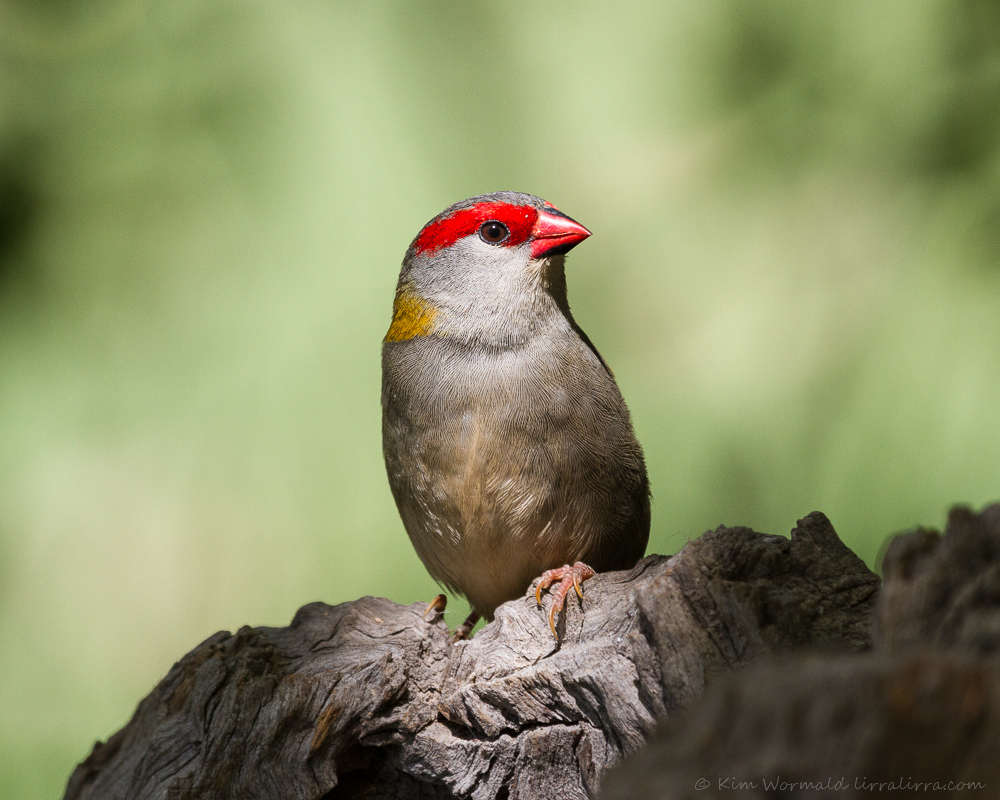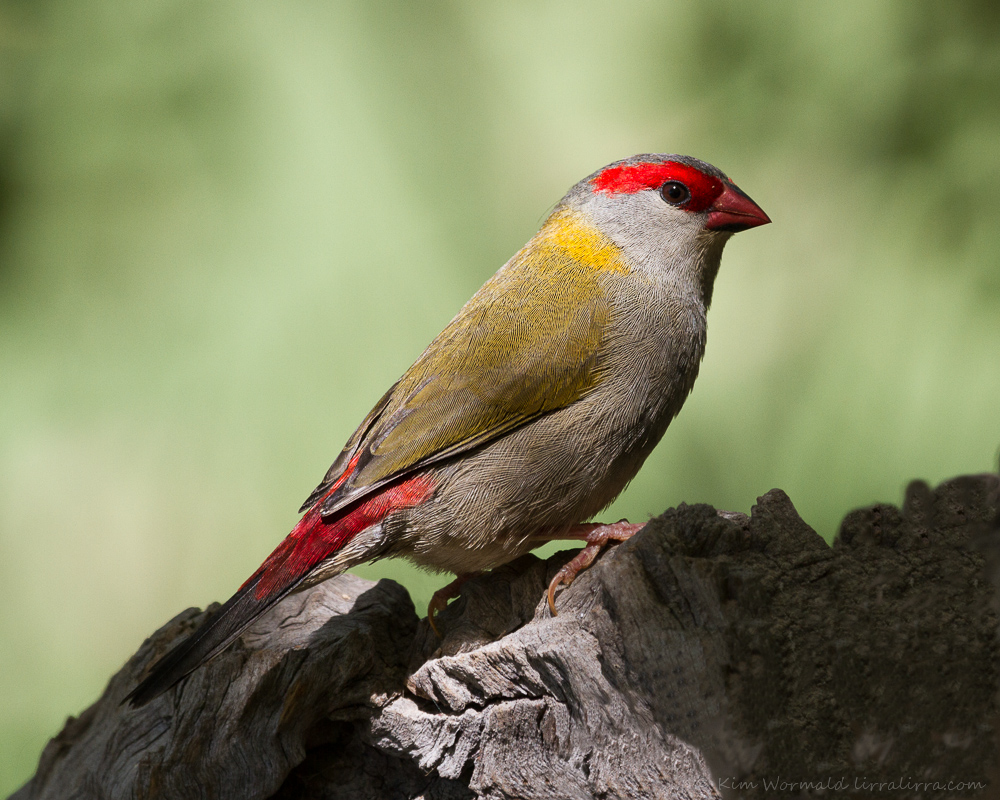This week’s birding was significantly reduced thanks to my appendix. I did manage to get outside but instead of roaming I hid amongst bushes and waited. The surgeon said my camera is too heavy so I propped it on my monopod – I’d have hobbled away from A&E if he’d mentioned that side effect!
I managed to get some sweet shots of Red-browed Finches and a juvenile Spotted Pardalote and will also share some post-processing I trialled on last week’s posing dotterel image.
 Red-browed Finch (Neochmia temporalis)
Red-browed Finch (Neochmia temporalis)
Canon 7D, 100-400mm L IS USM, 1/400, f/7.1, ISO 200, focal length 400mm
Red-browed Finches are tiny birds that can been seen in small flocks feeding on grass seeds, either pottering around on mown grass or perched on stems to reach longer seed-heads. At 11cm in length and 11g in weight even a flock of thirty can be difficult to see unless the grass has been cut short. Their underparts and heads are grey, their bills are red and black, they have golden patches on the sides of their necks and bold red eyebrows. According to Morcombe’s field guide males and females can be determined by whether the eyebrow tapers at the nape or is more square-cut. If anyone can tell if this bird is male or female please let me know via the comments section or email.
 Red-browed Finch (Neochmia temporalis)
Red-browed Finch (Neochmia temporalis)
Canon 7D, 100-400mm L IS USM, 1/400, f/7.1, ISO 200, focal length 400mm
I liked how this pose shows the Red-browed Finch’s back and perfectly illustrates the reason they used to be called Red-browed Firetails (a name I prefer). Their rumps and upper-tail coverts are bright red. Despite the amount of colour on their plumage these little finches are often difficult to see, their olive backs camouflage them well. When flushed from grass they’ll keep low as they fly for cover. Even their call is not always easy to hear as it is a high-pitched, thin squeak.
 Spotted Pardalote (Pardalotus punctatus) – juvenile
Spotted Pardalote (Pardalotus punctatus) – juvenile
Canon 7D, 100-400mm L IS USM, 1/500, f/5.6, ISO 320, focal length 340mm
Spotted Pardalotes are arguably Australia’s most beautiful bird. This juvenile is yet to get the exquisite plumage it will have as an adult but I still find it totally adorable. This little fellow is about 8-10cm long and 8g, you could gently close your hand around it without hurting it.
 Black-fronted Dotterel (Elseyornis melanops)
Black-fronted Dotterel (Elseyornis melanops)
Canon 7D, 100-400mm L IS USM, 1/640, f/5.6, ISO 100, focal length 400mm
Now for the post processed dotterel image: I haven’t changed the bird itself but I used Photoshop Elements 11 to clone and heal a few distractions that spoiled the image I posted last week in Dotterels posing, mating and displaying.
It’s like a ‘spot the difference’ game now – if you click on the link above you can toggle back and forth between the two images. How many differences can you see? I removed bits and pieces including rocks, particularly a large rock that spoiled the outline of the dotterel. I also changed the crop to a more pleasing 4×5 ratio which shows more foreground and improves the balance. In last week’s shot there is a hint of whitewash at the bottom edge, it was part of a large dollop of whitewash that needed to be removed when I changed the crop. The foreground was dull with the bird poop covered so I added a few sparkles.
I don’t plan to use Photoshop Elements often but I am excited about the potential to improve images with fairly minor distractions. Being more house-bound this week was an ideal time to practise and I’d appreciate feedback as I start fiddling about with cloning and healing tools.
Happy birding and healthy appendixes, Kim

Hi. I’m watching my series of bird baths in Highland Valley. I just saw a spotted pardalote but with a red beak! Is it possible that red browed finches and pardalotes mate?
Hi Gayle, what a fascinating sight! Did you get any photographs? Some unusual hybrids do occur but I’ve never heard of a pardalote/red-browed finch cross. Another possibility, if the pardalote looked normal otherwise, is whether it had stained its beak somehow or whether there was a reflection involved.
Spotted the same in my morning garden, Ballarat Victoria. Definitely a red brow, lemon breast, spotted back!
They go in through a hole about the size of a ten piece cent if that
I don’t know how long they live for, but they have always been there.
Sometimes you see the parent in the tree next to the driveway
I’m not sure how long they live either, some small birds can live long lives but I’d say you’d have had a succession of generations sharing your home.
We have pardalotes that have been breeding in the side of our house for about 15 yrs, lovely little birds
Hi Judy, that would be wonderful! Could you send me a email if you’d ever be happy for me to pop round (not that I know where you are other than Australia) and see them?
Hi, not a problem, we live in Sydney,
I have always wondered about them as no one else seems to know about the bird
Thank you! Pardalotes are so tiny that people often don’t see them. If you haven’t already seen it you might enjoy the post I called Pardalotes tunnelling
Only just seen this transformation. Well done Kim! Some people get all upset when photographers use a program to remove distracting elements (no pun intended) from their images. I rarely do, but you have shown here how much a photo can be improved by removing distracting elements (no pun intended) without overdoing it and altering the integrity of the photo. Go for it! And don’t feel obliged to tell us unless you want to show us how much improvement is to be gained, as you have here.
Hi Neil, I was so surprised to see your comment as I couldn’t remember working on an image like this until I reread my post. I don’t have Elements any more and would have to be house-bound for a week to bother doing this much photo-shopping. ‘Nature’ and ‘wildlife’ images for national/international competitions cannot have any element added or removed apart from cropping so photo-shopping isn’t something I’ve perfected, though I have experimented on rare occasions for non-nature/wildlife shots, generally with much frustration. I prefer to try photographing from a different angle, if possible, so any distractions are minimised. I did this yesterday, by coincidence, when a fairy-wren landed on a fence with a distracting background – by lying on the ground and looking at the wren from a lower angle the distractions disappeared (luckily the wren didn’t). If the wren shots are any good (taken at high ISO) maybe I’ll be able to share them. Thanks for your comment, you certainly got me thinking 🙂
As an earlier comment mentions, the detail in your images is amazing. Thanks for the inspiration.
Thank you Hannah
Kim – very impressive and inspirational – makes me want to get a camera and get out there. ‘So just do it I hear you cry’ quite right.
Hi David, thank you and yes, definitely do it!
wow, i discover new species, wery impressives colors, and good quality of your pictures, a real pleasure to dicover, thanks kim
ps : your captcha is fun, but don t put harder calculation please lol
Thank you Eric, I’m so glad you liked the new species you discovered 🙂 Hey, wouldn’t it be good to have some kind of bird related captcha, maybe with simple questions about birds …
WOW! These photographs are great and the detail on those little finches is amazing.
One of my favourite things about bird photography is seeing the details, especially in such tiny birds that often move so rapidly. I’m glad you like it too.
[…] final image, do not have yellow throats. There’s an image of a juvenile Spotted Pardalote in Red-browed Finches and PS11 that I would have saved for today’s post if I’d known I’d be lucky enough to […]
Great pictures again. The quality is always a surprise. I love how you capture a bird’s personality – not just its image.
What a lovely comment! Thank you 🙂
These are lovely Kim!
Thank you Mia 🙂
I prefer red browed fire tail too. It sounds more exotic.
I heartily agree!
Hot damn, you’re getting good lady 🙂
Oh yay! That’s a beaut compliment coming from a professional, thank you. Though I did look twice to make sure it wasn’t spam 😉